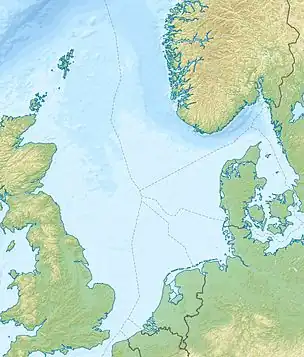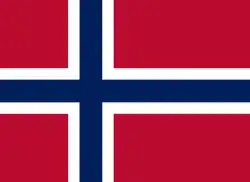| Gullfaks | |
|---|---|
 Gullfaks A being completed in Stord | |
 | |
| Country | Norway |
| Location | North Sea |
| Block | 34/10 |
| Offshore/onshore | offshore |
| Coordinates | 61°12′54″N 2°16′48″E / 61.215°N 2.280°E |
| Operator | Equinor |
| Partners | Petoro |
| Field history | |
| Discovery | 1978 |
| Start of production | 1986 |
| Peak of production | 180,000 barrels per day (29,000 m3/d) |
| Peak year | 2001 |
| Production | |
| Current production of oil | 39,000 barrels per day (~1.9×106 t/a) |
| Year of current production of oil | 2013 |
| Estimated oil in place | 73 million barrels (~1.0×107 t) |

Gullfaks is an oil and gas field in the Norwegian sector of the North Sea operated by Equinor. It was discovered in 1978, in block 34/10, at a water depth of 130-230 meters.[1] The initial recoverable reserve is 2.1 billion barrels (330×106 m3), and the remaining recoverable reserve in 2004 is 234 million barrels (37.2×106 m3). This oil field reached peak production in 2001 at 180,000 barrels per day (29,000 m3/d). It has satellite fields Gullfaks South, Rimfaks, Skinfaks and Gullveig.[2]
Platforms
The project consists of three production platforms Gullfaks A (1986), Gullfaks B (1988), and Gullfaks C (1989).[1] Gullfaks C sits 217 metres (712 ft) below the waterline and the height of the total structure measured from the sea floor 380 metres (1,250 ft),[3] making it taller than the Eiffel Tower. Gullfaks C holds the record [4] of the heaviest object that has ever been moved to another position, relative to the surface of the Earth with a total displacement between 1.4 and 1.5 million tons.[5] The platform produces 250,000 barrels per day (40,000 m3/d) of oil. The Tordis field, which is located 11 kilometres (6.8 mi) south east of Gullfaks C, has a subsea separation manifold installed in 2007 which is tied-back to the existing Gullfaks infrastructure.[6][2]
| Installation | Gullfaks A | Gullfaks B | Gullfaks C |
|---|---|---|---|
| Type | Concrete gravity platform | Concrete gravity platform | Concrete gravity platform |
| Function | Drilling, production, storage, accommodation | Drilling, production, accommodation | Drilling, production, accommodation |
| Location | SW part of field | NW part of field | |
| Water depth, metres | 135 | 142 | 216 |
| Fabrication substructure | Norwegian Contractors Stavanger | Norwegian Contractors Stavanger | Norwegian Contractors Stavanger |
| Topsides design | Aker Engineering and Foster Wheeler | Aker Engineering and Foster Wheeler | |
| Substructure weight, tonnes | 340,000 | 173,000 | 370,000 |
| Topside weight, tonnes | 40,000 | 25,000 | 49,000 |
| Accommodation (crew) | 330 | 160 | 300 |
| Legs | 4 | 3 | 4 |
| Cells | 24 | 19 | 24 |
| Storage capacity, barrels | 180,000 | Nil | |
| Well slots | 42 | 42 | |
| Wells | 21 production, 17 injection | 20 production, 13 injection | |
| Throughput oil, barrels per day (bpd) | 245,000 | 150,000 | |
| Water injection, bpd | 4 x 95,000 | 95,000 | |
| Platform installed | 1986 | 1987 | May 1989 |
| Production start | 1987 | 1988 | January 1990 |
| Oil production to | 2 x SPM buoys (8,400 m3/hour) | Gullfaks A | |
| Gas production to | Statfjord C | Statfjord C |
Incidents
Between November 2009 and May 2010 a well being drilled from Gullfaks C experienced multiple well control incidents which were investigated by Petroleum Safety Authority Norway and summarized in a report released on 19 November 2010. The report stated that only chance prevented the final and most serious incident on 19 May 2010 from becoming a full-scale disaster.[8]
Geology
The reservoir consists of delta sandstones from the Middle Jurassic Brent Group, shallow-marine Lower Jurassic Cook Formation sandstones, and the fluvial-channel and delta-plain Lower Jurassic Statfjord Formation.[1]
See also
References
- 1 2 3 Petterson, O., Storli, A., Ljosland, E., Nygaard, O., Massie, I., and Carlsen, H., The Gullfaks Field, 1992, in Giant Oil and Gas Fields of the Decade, 1978-1988, AAPG Memoir 54, Halbouty, M.T., editor, Tulsa: American Association of Petroleum Geologists, ISBN 0891813330, pp. 429-446
- 1 2 Statoil
- ↑ Structures
- ↑ "Heaviest man-made object moved".
- ↑ Lindberg, Björn. "How large is a troll?". INDUSTRIMINNE.NO.
- ↑ Amazing Structures, author Michael Pollard Page 34,35
- ↑ Oilfield Publications Limited (1985). The North Sea Platform Guide. Ledbury UK: Oilfield Publications Limited. pp. 276–83.
- ↑ "summary letter in English" (PDF). Archived from the original (PDF) on 2011-07-26. Retrieved 2011-11-14.
External links
 Media related to Gullfaks Oil Field at Wikimedia Commons
Media related to Gullfaks Oil Field at Wikimedia Commons- Gullfaks (Statoil website)
- Gullfaks facts and interactive map
- Gullfaks C at Structurae
- Offshore Technology
